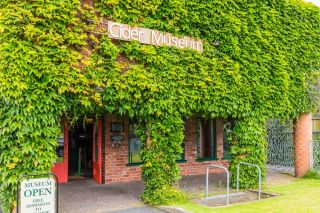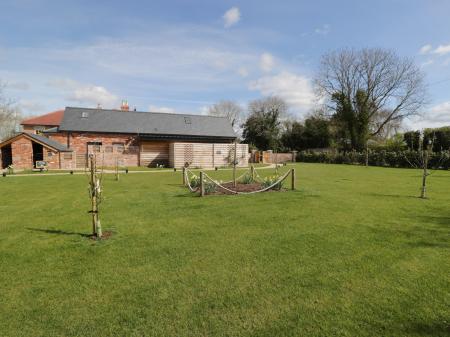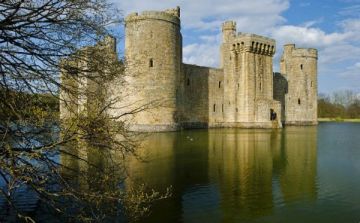
There are displays on the history of cider making over the centuries, including historic machinery and tools. There is a recreation of a cooper's workshop and vat house to explore, and the original cider champagne cellars used by the distillery.
One of the most interesting historical objects is also one of the largest; occupying a specially-built two-storey entrance gallery is a 17th-century French beam press, with a heavy counterweighted arm attached to a wooden screw for increasing the pressure on a load of apples.
Another historical oddity is an 18th-century 'scratter', used to crush apples to a pulp, brought from an estate near Honiton in Devon.
One nice feature is that you can listen to recordings of local oral history, telling about life and work in the cider industry years ago. There is also a series of Victorian watercolour paintings depicting perry pears and cider apples. A special exhibit displays English lead crystal cider glasses dating back to the 18th century.
The Cider Museum is run by a charitable trust whose aim is to preserve the history of cider making worldwide, not just in Herefordshire. With that in mind, the museum displays a huge range of items associated with the making of cider and perry, including drinking horns, ageing casks, cooper's tools, cider mills and presses, company records, advertising posters and packaging materials, distillery machinery, historic photographs, and much more.
One special exhibit showcases a rare 18th-century set of English lead crystal cider glasses and decanters.
The museum includes a 19th-century board room, part of the former cider works owned by HP Bulmer. The board room walls are lined with old photos of Bulmer family members.
Pomona Gallery
Pomona is the traditional term for a book illustrating cider fruit varieties. A special Pomona Galery showcases original watercolour illustrations of different apple and pear varieties, along with pomonas published in 1811, 1875, and 1987. There are also several antique books on cider making, including a rare 1691 edition of 'Vinetum Britannicum, or A Treatise of Cider' by John Worlidge.
Devonshire Colic
One of the museum highlights is a recreation of a farm cider house showing traditional equipment. Another feature looks at the practice of paying workers an allowance of cider instead of cash.
This cider allowance was known as 'truck'. Until it was declared illegal in the 19th-century workers would carry their 'truck' into the fields in a cask called a costrel. Some of the costrels were lined with lead, and if the lead leached into the cider it led to poisoning known as Devonshire Colic.
Wassailing
Learn about apple-related activities such as traditional Yuletide wassailing, an activity that goes back to the pagan period. Wassailing takes place on 6 January (Twelfth Night). guests bear lanterns to an orchard where they circle an apple tree three times, light a bonfire, and pour cider onto the tree.
They then fire a shotgun to frighten away evil spirits. A 'wassail bowl' of cider is passed around for everyone to have a drink and offer a toast, then the event is capped by singing and Morris Dancing.
Another display looks at the life of a travelling cidermaker, itinerant workmen who travelled from farm to farm with portable equipment for making cider. Gangs of cidermakers worked together to transport the heavy equipment, and they were paid according to the quality of the cider the produced.
Did You Know?
Traditional cider making was a slow process. On average only 100 gallons of cider could be made in a day (roughly 4,500 litres). The slow speed of hand production led to many attempts to mechanise the process. The first hand-operated mill appeared in the 17th century. It was called the Ingenio and was based on a Cuban sugar mill. It could process cider apples three times faster than traditional stone mills.
Perhaps the most interesting part of the museum is the cellar, where you can see how cider was made by the Bulmer company. Follow a signposted route following the production cycle and see how the process was mechanised for mass production.
See a Cooper's shop where skilled craftsmen made watertight casks for fermenting, storing, and transporting cider. Then there is the Vat house where cider was stored in huge oak vats until ready. The largest vat has a capacity of some 500 gallons, which is minuscule compared to modern vats which can hold as much as 1.65 million gallons.
The Bottling Line shows how cider was bottled in the early 20th century, and here you can listen to recordings by men and women who worked in the cider factory.
A special storage area in the cellar is set aside for Champagne Cider, which required a special process.
There is a research library associated with the museum where interested people can dig deeper into cider making history. The museum hosts a regular series of special events, including art exhibitions, cider and perry competitions, and cider making festivals.
Cider Music
And here's a little something extra you wouldn't expect from a cider museum - the museum owns a Steinway concert grand piano as a result of an anonymous bequest, and make this marvellous instrument available to the people of Hereford.
The piano is located in Holy Trinity church to take advantage of that building's superb acoustics and is available for performance hire, professional and serious amateur recitals, and educational use.
Getting There
The Cider Museum is located on Pomona Place, just off the A438. There is a large, free car park outside the museum, which is well-signposted around the city centre. The museum is about a 20-minute walk from the cathedral.
 We've 'tagged' this attraction information to help you find related historic attractions and learn more about major time periods mentioned.
We've 'tagged' this attraction information to help you find related historic attractions and learn more about major time periods mentioned.


